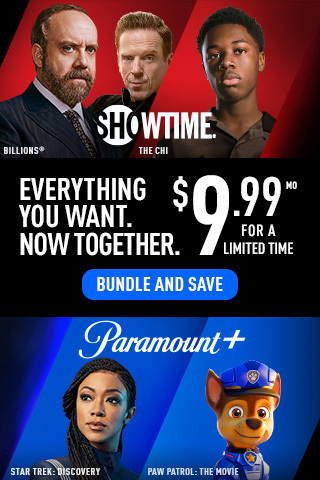
With recession fears looming, price cuts are beginning to pop up across the movie landscape at video streamers, while being considered by theaters. In some cases, these take the form of bundling multiple streaming services or offering a cheaper advertising-supported streaming service, as Netflix and AMC+ have done recently.
NBCUniversal’s mainstream video streamer Peacock this week unveiled a massive discount offer. The Comcast-owned Peacock practically gives away a year’s subscription for $19.99. That’s for a full year, not a month, working out to $1.67 a month.
To gain traction, Paramount+ offers rolling non-stop promotions that can yield deeply discounted subscriptions. Right now, three months of Paramount+ is promoted at $5.99/month, discounted from $11.99 normally.
Free is even possible! “Practically every month, [Paramount+] doles out coupons for a month of free service, valid for both new and returning subscribers,” Jared Newman wrote on TechHive in March. “As long as you don’t already have an active subscription, you can redeem these coupons repeatedly and never pay for Paramount+.” Such ploys fatten up announced subscriber counts and provide eyeballs for streaming ads.
What’s happening? Discounters lunge for a larger share of consumer spending: Convergence Research estimates that the 80 U.S. video streamers generated around $50 billion in revenue last year.
Thus, every 1 percent of U.S. market share is worth $500 million in revenue, regardless if money received is at a discount price, or if a subscription is expected to be profitable or not. Industry knows discounting likely will pull out revenue from rivals that stick to lofty full pricing. So, expect discounting in its various forms to mushroom, particularly as the economy visibly slows, making consumers more price-sensitive.

At the CinemaCon movie-theater convention in Las Vegas in April, cutting cinema ticket prices to spur more unit ticket sales was embraced. The $10.53 national average ticket price discourages middle- and lower-income families, and all the film distributors and exhibitors on the CinemaCon panel discussion spoke favorably about benefits of enticing more total patrons with lower unit prices. “Every studio has a different philosophy on pricing,” said Paramount Pictures president-domestic distribution Chris Aronson. “And that is a challenge.”
Discounting may seem like heresy in an era where top tickets to a Taylor Swift concert go for $1,000 … or more! But such peaks are not reflective of the general consumer market and sky-high pricing does not generate high volume, but simply caters to a limited market of high-rollers.
Another form of discounting is bundling, which is multiplying. Comcast, which owns NBCUniversal, announced May 23 that it is bundling its Peacock streamer for free with its Now TV subscription of 40 linear TV channels at $20 a month (full-priced basic cable bundles are $60 a month but losing popularity fast). “NOW TV was built to meet the needs of the value-conscious consumer who wants an entertainment product that is simple and convenient,” Comcast says.
Elsewhere jumping on the bundling bandwagon, Paramount+ is combining with corporate sibling Showtime; Disney ponders bundling its majority-owned Hulu with Disney+; and independent Chicken Soup for the Soul (streamer Crackle) introduces a unified offer coupled with a rewards program.
Speaking at an investors conference May 18, Warner Bros. Discovery CEO David Zaslav said of bundling, “If we don’t do it to ourselves, I think it’ll be done to us.” That means platforms like cable TV operators or multichannel streamers like Roku that host streamers will combine them in a single consumer offer.
The top streamers are led by Netflix, the runaway leader with 251 million subscribers globally and holding an early window for fresh theatricals from Sony Pictures. Next are Disney+ and Max (just rebranded from HBO Max from Warner Bros. Discovery) with sizeable originals and major Hollywood studio catalog content.
More distant are Paramount+ and Peacock from NBCUniversal. They possess major-studio film/TV program catalogs of their corporate siblings but lack breadth of streaming originals. Sony Pictures is the only one of Hollywood’s five major studios without its own mainstream steamer (again, Sony licensed its valuable fresh movies to Netflix for an early streaming window).

There is a counter-trend to raise streaming prices, as media companies try to stem streaming red-ink and lift their streamers to operating profitability. But announced top prices are subject to limited-time discounts like the Peacock offer or reductions from bundling.
Media companies were caught unaware when streaming subscriber counts leveled quick. Disney disappointed Wall Street on May 11 with earnings revealing Disney+ lost 4 million subs (for 138 million subscribers worldwide), after a price hike. Stock analysts forecast a 1.7 million subscriber gain at Disney+.
Paramount Communications reported May 4 that it incurred a $551 million first-quarter loss for its direct-to-consumer (DTC) business segment dominated by streaming. That sizeable red ink gushed in just three months, though Paramount says it’s on a path to DTC profitability. Paramount cut its stock dividend because of streaming red ink.
Cutting programing outlays is the new watchword, as for example Disney alerted investors that it plans to take a $1.5 to $1.8 billion write-off on programming and streaming, after a corporate regime change triggered a strategic rethink. With streamers reducing originals that are often big magnets for subscribers, expect more reliance on marketing ploys and price cuts to nab subscribers.
In another sign of worrisome streaming economics, indie film/TV programmer Lionsgate is pursuing a separation from its Starz premium pay TV channel business. Though Hollywood’s largest indie, Lionsgate found transplanting Starz into streaming too costly and mainstream streaming services require huge program libraries with global reach to work.
The enthusiasm around video streaming turned in the past year as losses mounted, subscriber forecasts were trimmed, subscribers displayed a fickleness, and recession worries weighed down expectations. Regarding fickleness, consumers show an inclination to jump around — so called “darters” — who subscribe for a while when favored content premieres and then cancel.
The big worry is about recession — which means not getting too aggressive in pricing if consumer pocketbooks are pinched — as the Federal Reserve board ratchets up interest rates to try to tame inflation. The Fed discount interest rate to banks went from near zero just a year ago to 5.25%, and is still rising.
Related content:
Leave a Reply